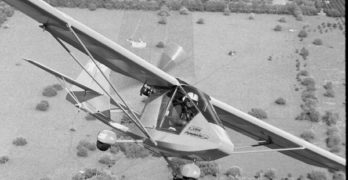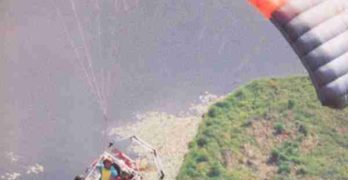UPDATE–November 2008: According to FPNA, an American company with a business relationship to A-20 producer Aeroprakt, the A-20 has been discontinued. Please contact FPNA for more information (contact info at end of article).
Two summers ago Americans saw a new aircraft from a Ukrainian company called Aeroprakt as U.S. importer Spectrum Aircraft brought in the A-22 Valor. It would be only the first in a fleet of new microlights.
Later another model from Aeroprakt appeared. In fact, the Vista series comprises 5 models, all variations on a basic theme that is nothing like the Valor. At present, the Ukraine enterprise has no less than nine models including the Valor, Vista, Cruiser, V-STOL, V-SS, Vulcan, Vulcan-SS, Victor single engine, Victor twin, and Viking. Four of this series are twin-engine aircraft, none are alike, and one is a 4-seater. By any measurement, this is quite an accomplishment from a company less than 10 years old and rising from the ashes of the failed Communist empire.
Search Results for : MG 21
Not finding exactly what you expected? Try our advanced search option.
Select a manufacturer to go straight to all our content about that manufacturer.
Select an aircraft model to go straight to all our content about that model.
Destiny Powered Parachutes
In recent months, several industry observers have noted that powered parachutes’ sales appear to be stronger than fixed-wing sales. Many visitors count a large number of powered parachute manufacturers at airshows. Insiders hear rumors about the large volume of engines these companies are buying. Perhaps you’ve even said, “There’s one flying at my home field now.”
Much like trikes before them, the sales of powered parachutes (and powered paragliders) seem to be increasing. Most new flying machine types have their day, and currently powered parachutes appear to be enjoying a great run.
Growing Segment
Despite the fact that the planet supports only a couple million pilots, aviation is highly segmented. Flyers in America enjoy the broadest choices imaginable with aircraft of every description. This incredible diversity is vast enough that we tend to focus only on the types of flying machines that interest us (or that we can afford).
The concept of a parachute (canopy) acting as your wing isn’t particularly new.
Single-Seat Gull 2000
In a flying world that seems to think a 2-seater is mandatory, Mark Beierle has released another single-place ultralight. And what a sweet ultralight it is.
I love the Thunder Gull series of ultralights. When people ask me what I personally like of the hundreds of ultralights evaluated, the Thunder Gull always springs to mind (among a few other designs). My interests may not be your interests, but I’ll bet most pilots would love to fly the Gull 2000.
Offered for sale here in the new millennium, the Gull 2000 is an appropriate name that seemed well aimed at lots of American ultralight enthusiasts.
Welcome to Gull 2000
For the new century, the Gull 2000 adds to, rather than replaces the older models from Earthstar Aircraft. The company will still sell their Thunder Gull J single-seater and their little-publicized Soaring Gull, which uses a very small engine and long wings to create something of a motorglider.
Dope and Fabric Hawk Arrow
One of the ultralight industry’s longest enduring designs is the Hawk. First offered in 1982, the Hawk flies today – 15 years later! – in essentially the same form. A few years ago the Arrow name was added to a refined version (becoming the Hawk Arrow) but the basics didn’t change. The original became the Hawk Classic.
So, why are we reporting on it? Two reasons quickly spring to mind.
First, the plane deserves it. This is an excellent little bird that has delivered a lot of aerial fun to virtually a generation of pilots. However, new pilots enter the community between articles and these aviators need to know this design still works well today like it did way back in the early ’80s when ultralights were new on the aviation scene.
Secondly, this isn’t the same Hawk.
Oh, it still looks much the same. Such a statement is hardly fair, though, to the many refinements that showed up on the plane I flew for this report.
Powrachute
Like a poised cat, restrained energy waiting for its opportunity, Powrachute sprang into the powered parachute industry and snapped up a share of this fast-growing aviation segment. In just a couple of years, the Kansas company has found some 300 buyers of their distinct ultralight.
Given their approach to the industry, perhaps using a “spokes tiger” is highly appropriate. A feline named Noah is featured in the company’s ads and on its brochure. As with the unusual spelling of the corporate name, Noah helps Powrachute stand out in a crowd. (Personally, I thought the letters meant Pow’r-a-‘chute, spelled in the shorthand way of vanity license plates.)
Until recently, the Kansas company offered a single 2-seat model – the PC2000 – which could be configured with various options. The PC2000 is a new design “for the 21st century.” However, despite its newness, even the PC2000 changed rather dramatically to add rollover protection which the company calls Frontal Fuselage Bars.
Skye Ryder Aerochute
Darlings of late-evening flying at airshows (when winds are calmer), powered parachutes are among the simplest and most fun of the ultralight class. If low and slow flying over inviting scenery sounds good, Six Chuter has your aircraft waiting.
Controls don’t get much simpler: right, left, aerodynamic braking (right and left together), and power for altitude changes. Lessons are therefore brief.
Powered parachutes are about the only segment of ultralight aviation that isn’t worried over their empty weight exceeding Part 103’s 254 pounds. The Skye Ryder I single place is a mere 205 pounds, way under the limit. The 215 pound Skye Ryder II is a two-seat trainer, therefore tipping the scales a whopping 281 pounds under the permissible weight!
Neither do they have a problem with the top speed limitation, flying as they do at 26 mph. The single place uses the 447 Rotax and earns a climb of 700 fpm.
St. Andrews Aviation — Viking II
St. Andrews Aviation boss Charles Dozier calls his new Viking II a “parachute plane” rather than simply a powered parachute. In one particular way it certainly isn’t like those which preceded the new aircraft: Viking II employs side-by-side seating in the first such example with which I’m aware among powered parachute aircraft. For those doing training in these machines, such side seating is usually considered optimal so the instructor can better interact with his student.
Ground steering is also made intuitive by employing a steering bar that works the way a bicycle does (whereas many powered parachutes use a joystick-type control for ground handling). Because the seats are alongside one another, Dozier was also able to centralize the throttle and nosewheel brake. Another benefit, says the designer, is a lowered center of gravity because the student or other occupant is not raised above and behind as in most powered parachutes.
For in-air steering – which requires the use of your feet on powered parachutes – the Viking II has a dual set of foot pedals such that either occupant can fly the machine while the other observes.
Joplin Light Aircraft — Tundra
The Tundra evolved out of experience with the old Beaver 650 that had loads of development but which never really got squarely on the market. Thanks to its resurrection by Laron a few years back, this desirable aircraft flies onward.
Today, the model is built by Joplin Light Aircraft who bought the design rights for the Tundra and 1/2-Tun (single seater). Joplin got started distributing ASAP products in the U.S. but has now grown into an Original Equipment Manufacturer to better implement their own improvement ideas.
One of these upgrades involves the impressive Geo-Suzuki engine. This 65-horse four stroke powerplant burns a mere 2 gph from its smooth-running three cylinders. Best of all the lively engine is priced at $4,995, well below that of some four-stroke options available to ultralight enthusiasts. Joplin makes the Tundra available standard with a Geo-Suzuki conversion, so adding the engine is simpler.
A tandem design, the Tundra is easily appreciated by larger American pilot because it enjoys a wide cabin with ample elbow room.
Harmening High Flyers — High Flyer 103
Former flight school operators Mike and Susie Harmening obviously know what powered parachute pilots want. The company is thriving and customers relate positive impressions about their contact with the couple. That they build a quality aircraft should therefore come as little surprise.
In a world of single place powered parachutes exceeding the $10,000 mark, the Harmening’s Buckshot offers a great value at $7,995 for an aircraft that can laugh at Part 103 definitions. Tipping the scales at a mere 230 pounds you can afford some accessories; for example, the company says you can install the Rotax 503 (over the standard 447) if you wish.
For well under $10,000, the Harmening family organization can supply their original High Flyer that can be either a one or two seater, and stay under Part 103’s single seat restriction, a nice compliment to the effort to keep weight low. Some other designs seem to get their strength from the sheer quantity of tubing used.
ASAP — Summit Powered Parachute
After saving two leading Canadian ultralight designs, refining, building, and marketing the Chinook and Beaver 550, plus operating their successful machine shop enterprise, they also started producing their own powered parachute, the Summit. And as they did with the other ultralights, they made changes to bring improvements they felt were needed.
ASAP changed the control system from the standard foot-tubes that create lateral control on most powered parachutes. Summit uses “foot platforms.” Accessible only to the front seat pilot, the platforms (like rudder pedals) effect a turn in the direction pushed. When you push on one platform it slides on a rail to input the control to the canopy trailing edge.
Steering on the ground also takes a new turn. Instead of a joystick-type control common to other brands, the Summit employs a control wheel that moves the nosewheel only. A lever on this yoke activates a nose drum brake.
Summit supports its parachute canopy from four points, not unlike the Para-Ski but quite differently than most powered parachutes which suspend from a couple common points.











